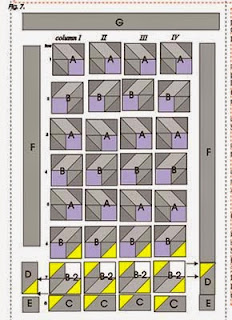Last week, I showed one of the quilts in my new ebook, Quilts for Coffee Lovers. Here's another:
It's done in raw edge appliqué, using a machine zig-zag. The red lines are coffee stirrers, and there are buttons between the stirrers and in the four corners.This is a research-based quilt. If you've ever been serious about making a good cup at home, and looked into the subject, you know the coffee
- water temperature
- timing of grind
- fineness of grid
- relative quantities of water and coffee
- timing of pour
- height from which the water is poured, no kidding
- and, of course, the gadget. The gadget makes a HUGE difference.
In particular, I was stunned by how appallingly bad percolated coffee tasted. Why did anyone in America drink coffee during the first half of the 20th century?
So for this quilt, I drew 6 of the most picturesque gadget choices that I could find in cyberspace. They include a Moka pot, a percolator, an Aeropress, a vacuum maker, a drip filter holder, and a French press. Here are the first four:
- Good Gadget
- Good Coffee
- Good Grind
- Good Cup
- Good Beans
- Good Friends
- Good Luck
Anyone who wants to make their own version can personalize it with their own 4 favorite devices, and their 4 favorite phrases. Perhaps the most important, imho:
What system did I end up with? I finally bought a Bodum Bistro burr grinder (about $100), the first grinder I'd owned in many years. And I bought a Bonavita drip coffeemaker (about $130). $230 is not cheap, but it would have been very easy to spend a whole lot more. My family is happy with the coffee since then - usually delicious - and after about a year, all the equipment is still working.
Sometimes, for just one cup, I use the Aeropress, a strange little device that my friend Sam gifted me, thanks Sam!
It makes the most reliably delicious single cup I've ever made at home, and it's not expensive at all, at around $30! (No financial affiliation with any of these products!)
What are your secrets to coffee success? Let me know. More information about my coffee quilts pattern book is here,




























